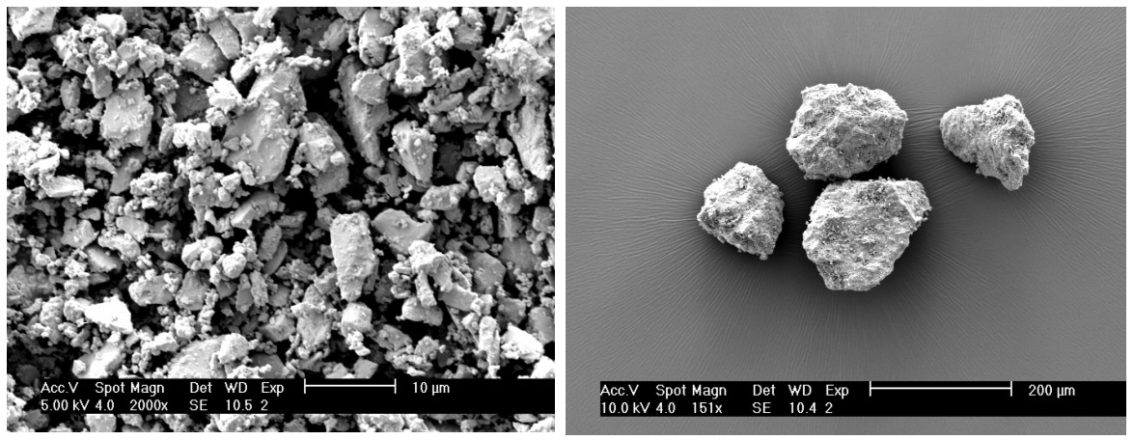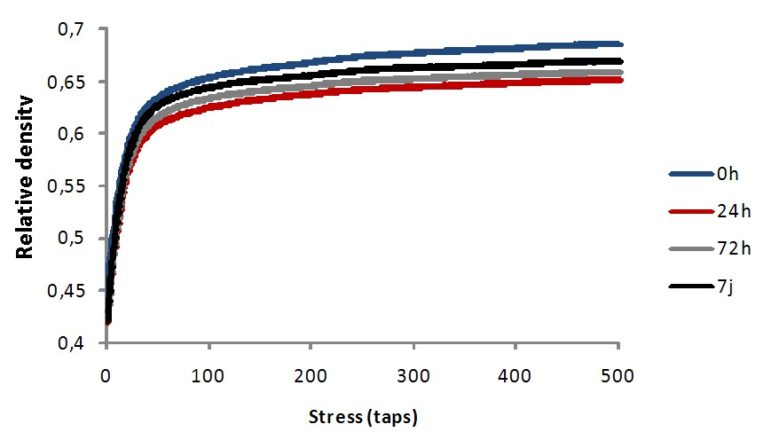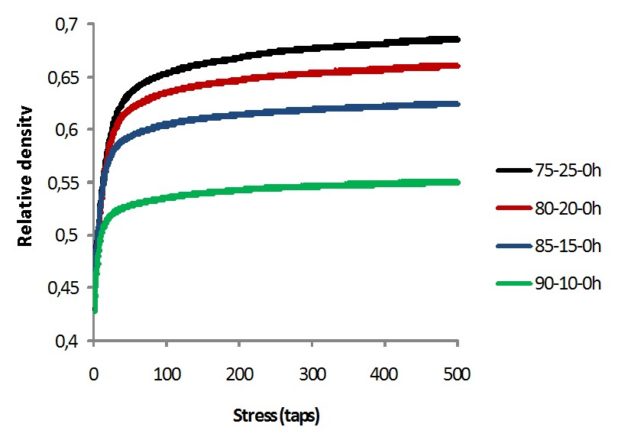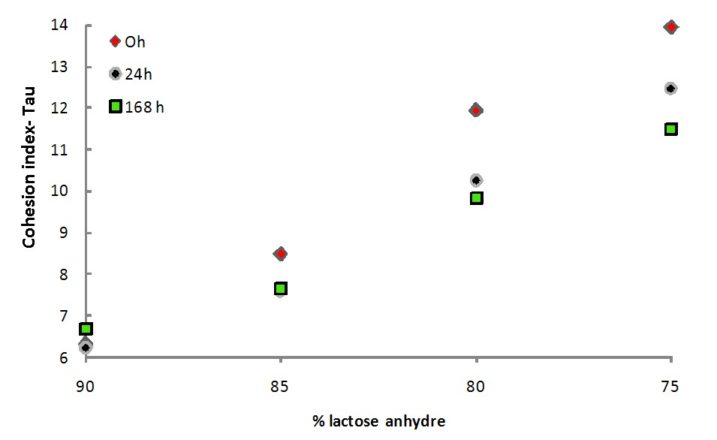Pharmaceutical
Ageing study of lactose’s blends by using dynamic compaction curves
Dry powder inhalers (DPI) offer many advantages to the respiratory administration. They show a targeted effect (they do not diffuse towards inappropriate sites in the body), they attain higher concentrations in the lungs resulting in a considerable reduced drug dose.
Principle
Dry powder inhalers (DPI) offer many advantages to the respiratory administration.They show a targeted effect (they do not diffuse towards inappropriate sites in the body), they attain higher concentrations in the lungs resulting in a considerable reduced drug dose.
Moreover, this administration is faster than the other one’s.
In DPI, the quantities of drug delivery depend on the device design, the patient inhalation manipulating and also from the carriers (excipient).
These lasts play an important role in the administration of the drugs.
Therefore, in order to assure the desired drug delivery, the flowability of the blend (mix of carriers and drug) inserted in the pill has been controlled.
To increase the efficiency of the administration, two kinds of particles may be used in the formulation: fine lactose particles and coarse lactose carrier. On one hand, fine lactose particles allow the improvement of the fine particle fraction (FPF) and the efficiency of the administration. On the other hand, the coarse particles allow increasing the flowability of the blend during the pill emptying by the patient.
In this research, we discuss the effect of the formulation on the flowability of the blend by considering that the strength interaction
between fine and coarse particles are the lowest in this system [1,2].
In order to check the evolution of flow properties of the blends with ageing, a new instrument was used: the GranuPack. It allows the recording of a compaction curve. A powder sample is put in a tube which is submitted to a series of identical stress (taps).
Before measuring, an initialization procedure is made in order to avoid any bias. During the stress procedure, the volume fraction of the powder is tracked in order to estimate the relevant information: a dimensionless flowability index is obtained ranging typically from 3 (high flowability) to 30 (low flowability). The Hausner ratio can be also calculated by using the recorded data.
LEARN MORE ABOUT THE GRANUPACK
Materials
Micronized lactose with a size around 2 µm and coarse lactose with a size around 120 µm were used in this study.
Figure 1 shows micrographs of the two powders.
Four blends have been prepared by mixing coarse and fine powders in different mass ratios: 90/10, 85/15, 80/20 and 75/25. Figure 2 shows the studied blends.
Figure 1: fine lactose (A) and coarse lactose particles (B) and Figure 2: electron micrographs of blends prepared in different mass ratio (coarse /fine particles): 90/10 (A), 85/15 (B), 80/20 (C) and 75/25 (D).
 and coarse lactose particles (B).jpeg)
Figure 1: fine lactose (A) and coarse lactose particles (B)

Figure 2: electron micrographs of blends prepared in different mass ratio (coarse /fine particles): 90/10 (A), 85/15 (B), 80/20 (C) and 75/25 (D)
Results and Discussions
The flowability of the different blends has been studied at different ageing time (0 – 24 – 48 – 72 – 168h) by using the GranuPack instrument.
Table 1 gives the flowability index and the standard deviation recorded for the different aged powders.
The p value calculated from the obtained results for an ageing time varied between 0 and 24 hours are respectively: 0.02 (75) ; 0.03 (80) ; 0.07 (85) and 0.68 (90).
LEARN MORE ABOUT THE GRANUPACK
By analyzing these results, no significant modification in the flowability behavior can be detected for powder 90/10 unlike for powders 75/25 and 80/20.
Figure 3 shows respectively the tap density curves obtained by using the GranuPack for the 75/25 blend at different ageing time (figure 3A) and for different blends (figure 3B) before ageing.
| Ageing Time (Hours) | % of coarse lactose in the blend | |||
|---|---|---|---|---|
| 90 | 85 | 80 | 75 | |
| 0 | 6.3 ±0.1 | 8.5 ± 0.5 | 11.9 ± 0.6 | 13.9 ± 0.7 |
| 24 | 6.2 ± 0.2 | 7.6 ± 0.3 | 10.3 ± 0.4 | 12.5 ± 0.3 |
| 168 | 6.7 ± 0.2 | 7.6 ± 0.3 | 9.8 ± 0.2 | 11.5 ± 0.6 |
Table 1: flowability index and the standard deviation recorded for the different aged powders

Figure 3A: tap density curves for the 75/25 blend at different ageing time

Figure 3B: tap density curves for the different blend compositions before ageing
By considering the figure 3B, we can observe relevant differences between the flowability of the studied blends. In this figure, we can see that an increase of fine particles in the blend decreases the flowability of the powder. So, the 75/25 blend gives a higher flowability index (13.9) than the 90/10 powder (6.3).
The figure 4 shows as the quantity of fine particles in the blend is big as the ageing of the powder (through the flowability index) is highlighted.
So, on one hand, the 90/10 powder does not seem to be dependent on the ageing time and, on the other hand, the 75/25 blend is characterized by a significant increase of flowability depending on the ageing time (figure 3B and 4).
We can note that this improvement is particularly important during the first 24 hours.
This behavior could be due to the modification of the coarse lactose surface caused by the departure of the fine particles during the ageing time.
This phenomenon can explain the increase of the final density and the improvement of the flowability of the blends (lower cohesion).
The agglomerate of fine particles localized on the surface of coarse particles collapse (Figure 2C) and fine particles fill the space between the coarse particles.
This behavior is in good agreement with a previous studies realized by atomic force microscopy[1,2].
This phenomenon could be attributed to the dehydration of the fine particles directly in contact with the coarse lactose surface.

Figure 4: evolution of the flowability index for the studied blends at different ageing time
LEARN MORE ABOUT THE GRANUPACK
References
1]Handoko et al, Eur. J. Pharm. Sciences. 36(2009) 265-274.
[2]Adi Handoko et al, Pharm. Research, 23 (2006) 2556-2565.
